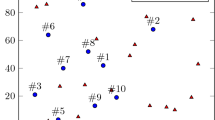Abstract
The mean-risk stochastic mixed-integer programs can better model complex decision problems under uncertainty than usual stochastic (integer) programming models. In order to derive theoretical results in a numerically tractable way, the contamination technique is adopted in this paper for the postoptimality analysis of the mean-risk models with respect to changes in the scenario set, here the risk is measured by the lower partial moment. We first study the continuity of the objective function and the differentiability, with respect to the parameter contained in the contaminated distribution, of the optimal value function of the mean-risk model when the recourse cost vector, the technology matrix and the right-hand side vector in the second stage problem are all random. The postoptimality conclusions of the model are then established. The obtained results are applied to two-stage stochastic mixed-integer programs with risk objectives where the objective function is nonlinear with respect to the probability distribution. The current postoptimality results for stochastic programs are improved.
Similar content being viewed by others
References
Ahmed S (2006) Convexity and decomposition of mean-risk stochastic programs. Math Program 2: 433–446
Bank B, Guddat J, Klatte D, Kummer B, Tammer K (1982) Non-linear parametric optimization. Akademie-Verlag, Berlin
Billingsley P (1968) Convergence of probability measures. Wiley, New York
Billingsley P (1979) Probability and measure. Wiley, New York
Dobiáš P (2003) Contamination technique for stochastic integer programs. Bull Czech Econ Soc 18: 65–80
Dupačová J (1986) Stability in stochastic programming with recourse: contaminated distributions. Math Programm Study 27: 133–144
Dupačová J (1990) Stability and sensitivity analysis for stochastic programming. Ann Oper Res 27: 115–142
Dupačová J (1995) Postoptimality for multistage stochastic linear programs. Ann Oper Res 56: 65–78
Dupačová J (1996) Scenario-based stochastic programs: resistance with respect to sample. Ann Oper Res 64: 21–38
Dupačová J (2006) Stress testing via contamination. In: Marti K, et al (eds) Coping with uncertainty, modeling and policy issues, LNEMS 581. Springer, Berlin, pp 29–46
Dupačová J, Polívka J (2007) Stress testing for VaR and CVaR. Quant Financ 7: 411–421
Dupačová J (2008) Risk objectives in two-stage stochastic programming models. Kybernetika 44: 227–242
Konno H, Yamazaki H (1991) Mean-absolute deviation portfolio optimization model and its applications to Tokyo stock market. Manag Sci 37: 519–531
Kristoffersen TK (2005) Deviation measures in linear two-stage stochastic programming. Math Methods Oper Res 62: 255–274
Krokhmal PA (2007) Higher moment coherent risk measures. Quant Financ 7: 373–387
Lulli G, Sen S (2004) A branch-and-price algorithm for multistage stochastic integer programming with application to stochastic batch-sizing problems. Manag Sci 50: 786–796
Märkert A, Schultz R (2005) On deviation measures in stochastic integer programming. Oper Res Lett 33: 441–449
Markowitz HM (1959) Portfolio selection: efficient diversification of investments. Wiley, New York
Ogryczak W, Ruszczyński A (2001) On consistency of stochastic dominance and mean-semideviation models. Math Program 89: 217–232
Römisch W (2003) Stability of stochastic programming problems. In: Ruszczynski A, Shapiro A (eds) Stochastic programming. Handbooks in operations research and management science, vol 10. Elsevier Amsterdam, pp 483–554
Römisch W, Vigerske S (2008) Quantitative stability of fully random mixed-integer two-stage stochastic programs. Optim Lett 6: 377–388
Schultz R (1995) On structure and stability in stochastic programs with random technology matrix and complete integer recourse. Math Program 70: 73–89
Schultz R (2003) Stochastic programming with integer variables. Math Program 97: 285–309
Schultz R, Tiedemann S (2003) Risk aversion via excess probabilities in stochastic programs with mixed-integer recourse. SIAM J Optim 14: 115–138
Schultz R, Tiedemann S (2006) Conditional value at risk in stochastic programs with mixed-integer recourse. Math Program 105: 365–386
Author information
Authors and Affiliations
Corresponding author
Additional information
This research was supported by the National Natural Science Foundation of China (grant numbers 10571141, 70971109).
Rights and permissions
About this article
Cite this article
Chen, Z., Zhang, F. & Yang, L. Postoptimality for mean-risk stochastic mixed-integer programs and its application. Math Meth Oper Res 74, 445–465 (2011). https://doi.org/10.1007/s00186-011-0373-2
Received:
Accepted:
Published:
Issue Date:
DOI: https://doi.org/10.1007/s00186-011-0373-2




